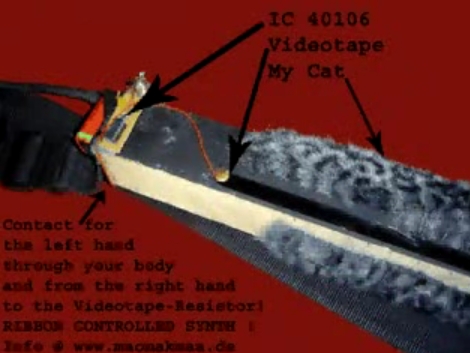
Behold the Bodystick, an instrument built and demonstrated by [Erich Lesovsky]. It’s a bit like a string bass but instead of strings there is a strip of VHS tape. Apparently not all VHS tape will work, but if you have the right kind you can run voltage through it and then change the resistance with a touch of your finger. It seems that the hand not touching the tape needs to be touching a conductive pad, completing the circuit. The resulting resistance changes the oscillator values on a CD40106 CMOS chip. This project is a bit out there (just like [Erich’s] Mega-Tape-O-Phone), and in keeping with its peculiarity is the demo video after the break. Enjoy!
[youtube=http://www.youtube.com/watch?v=wSDPzwa1YFE]















This reminds me a bit of a hack Laurie Anderson did — She replaced the string on her bow with a piece of audio tape, and put a tape pickup head on her violin, and she could move the bow back and forth to sample from the piece of tape. (She does this in one of her movie concerts – “Home of the Brave”, I think.)
Raveeee timmeeee xDD great sound :D
Please…. You don’t RUN voltage through anything. You can run a current through a wireless, not voltage.
Excuse me for splitting hairs, but you don’t put voltage “through” anything. Voltage is a difference in potential “across” something.
Carry on.
Wireless=wire. Dang autocorrection
@regis you got my attention so i looked into it, the so called tape-bow violin was Anderson’s creation although the version you refer to apparently uses MIDI based audio samples triggered by contact with the bow instead of a magnetic tape and head. And it can be seen in ‘Home of the Brave” during the “Late Show” segment, now off to find that clip…
Hay, that’s badass! But can’t you do it with a simple 555 timer. I have a 555 timer circuit already made on my breadboard, I never knew VideoTape was conductive AT ALL! But it makes sense, it’s Iron powder stuck to plastic isn’t it? I have GOTTA give this a try…
Ya, find that clip for me would ya? wold like to see it.
Mouse Jay: You may also want to try the old pencil mark resistor trick. Works for pitchbending. Try different thicknesses of marks and see what results you get :)
reminds me a little of http://tiny.cc/mrwai
In the synthesizer world, this known as a “ribbon controller”
Hay, I have a teensy arduino, can I make it emulate a usb midi controler, or should i program it as a USB mouse and use the mouse in FL Studio?
Any of the “Hub Feed” magnetic tapes that used graphite as lubricant would be worth investigating.
A prime example to start with is 8-track tape. There’s an interesting design element to 8-track tapes. At the switching point=where one audio program ends/the next one begins there is a metallic foil strip. That metal strip bridges a set of contacts to activate the head position solenoid. Over much of the format’s life span, the foil often was used to actually carry the solenoid current. And some attempts to have a transistor etc triggered by that foil were subject to graphite buildup on a spliced tape causing false track jumps.
Another historical tape re-use method was slit down computer tape being used for reel feed VTR’s. The lubricants that worked ok for computer data heads often left horrid deposits in video heads and on the various tape path bits.
@Mouse Jay: Yeah, the oscillator in this design is just a simple schmidt trigger (the ic for this would/should be much cheaper than a 555)
put the conductive pad in a seat and sit bare-assed?
then your music will sound like shit
old well known ribbon controller hack
“then your music will sound like shit”
Hahahahahah…. :D
@Oren Beck is a bit confused, no mag tape used graphite, or any, lubricant. It is the iron oxide itself that scrapes off old tapes and leaves a deposit on the heads.
Different tape compositions will give differet results, normal iron oxide, chrome, and so-called “metal tapes – you milage will differ.
In the conventional ribbon controller the player isn’t part of the circuit – the tape is held suspended just above a metal support and pressed down onto it, forming a variable resistor. this helps to avoid hum and noise injection.
An oldie, but still tres cool.
well shucks it appears poor Laurie never reached the level of fame required to have all of your work ripped off.
While I can’t find a clip of it I am hoping someone might be able to find it or rip and post it, not interested in the music (sorry Laurie it’s interesting but not that fantastic) just want to see this tape-bow violin.
also is anyone else thinking about a super-tech fart machine besides me? *braaaap*
His… CAT? 8-O
…
It remains me to this:
http://fletchtronics.net/diy-touch-potentiometer
better documented.
…
Here is your Laurie Anderson clip.
http://www.youtube.com/watch?v=vxXVSBN2-Bw
Her instrument was very different. It had (has?) a bow with prerecorded samples on it, and she played it across a magnetic pickup.
http://en.wikipedia.org/wiki/Laurie_Anderson#Tape-bow_violin
Thanks for posting that link Josh
yeah it’s a whole different beast and if I do say so myself this hack kills it in the function column. I am not really into performance art pieces nor am into most synthed stuff, but damn cool hack.
MUST be S-VHS or ADAT tape, as used in the Alesis ADAT home studio type recorders or late generation S-VHS style VCR’s. Standard VHS tape doesn’t do the trick, its not conductive. Also use an old plastic mini-blind with a conductive strip inside raised off of the surface. Here’s a modular synth ribbon controller example, although this one somehow uses standard ferric oxide tape (I think?): http://modularsounds.com/?p=689